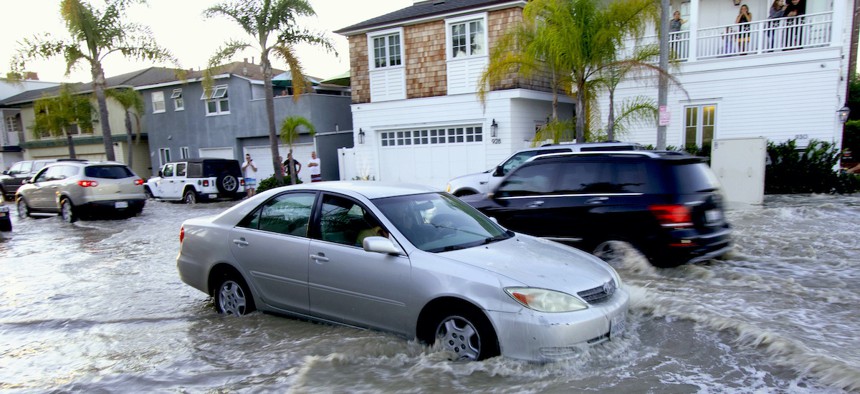Report: States Most Vulnerable to Climate Change Are Among the Least Prepared

Vehicles drive through flooded streets in Newport Beach, Calif., Friday, July 3, 2020. California is one of the states most vulnerable to climate change and is ranked "more prepared" for its effects than other states in a new report. Associated Press
New research suggests that states that are most vulnerable to the health effects of climate change—including flooding, food shortages and heat-related deaths and illnesses—have done the least to prepare to handle them.
Many of the states that are most vulnerable to the effects of climate change are least prepared to deal with it, according to research released this week by the Trust for America’s Health.
The report, a collaboration between the nonprofit and the John Hopkins Bloomberg School of Public Health, examines states’ ability to address the health effects of climate change based on their vulnerability, public health preparedness and existing climate-related adaptations. The results, researchers wrote, indicate that every state and the District of Columbia had done some sort of planning, but “there was significant variation and, in many places, a great deal of room for improvement.”
“Of greatest concern,” the report continued, “states with the highest levels of vulnerability—predominantly located in the Southeast—tended to be among the least prepared.”
Just two of the 17 states considered most vulnerable to climate change—North Carolina and Arizona—were ranked among the most prepared in the country. Eight of the remaining 15—Tennessee, Georgia, Kentucky, South Carolina, Texas, Mississippi, Oklahoma and West Virginia—ranked among the states least prepared to handle the negative health effects associated with climate change.
“This group of states faces increased hazards including hurricanes, floods, heat waves, and vector-borne diseases, but have done the least to prepare,” researchers wrote. “Overall, the more vulnerable a state was, the less prepared it tended to be.”
By contrast, states that had prepared well included Colorado, Maine, Maryland, New Hampshire, Utah, Vermont and Wisconsin, along with the District of Columbia. Maryland, for example, used “state-specific data to develop a baseline health assessment and identify risk factors” for residents, then used that data in conjunction with climate projections “to model current and future climate-related health impacts across the state and in four pilot counties.”
Climate change and its effects varied greatly from place to place and among different populations, so preparations can’t—and shouldn’t—be uniform nationwide, the report said.
“Given the size and diversity of the country, each state and its communities will experience climate change differently. State leaders must understand their particular risks and vulnerabilities in order to plan effectively,” it said. “In areas of a state where vulnerability is higher, state leaders should invest more in adaptation and preparedness. Likewise, states that are more vulnerable overall should go to greater lengths to adapt to climate-related hazards.”
Those hazards—things like an increase in heat-related conditions and deaths, upticks in food-borne illnesses and a surge of Lyme disease cases related to the northward expansion of tick populations—will affect groups of people differently even within a single state, depending on myriad factors. Low-income communities and people of color, for example, are likely to be disproportionately affected, the report said.
“Large portions of other groups, such as immigrants, people of color, people living in poverty, or people experiencing homelessness may have less access to resources that would allow them to avoid exposures, seek care or treatment, or navigate long-term recovery,” it said. “In many cases, vulnerability to the health impacts of climate change reflect existing health risk factors and disparities.”
To improve preparation, researchers recommend that state officials increase investment in public health and emergency management agencies, adopt a federal framework for climate change resilience, establish “ongoing, dedicated” funding and staff for work related to climate, and partner with both federal and local stakeholders. Officials should also “plan with communities, not for them,” the report advised.
“Preparedness officials must include members of communities at greatest risk—and compensate them for their involvement, when appropriate—in planning and decision-making,” it said. “Health departments and emergency management agencies should rely on the expertise of those who may bear a disproportionate risk, such as older adults, people with disabilities, and individuals with chronic health conditions,to ensure plans and procedures meet the needs of everyone. Community-driven planning strengthens resilience, as residents play a lead role in defining the challenges they face and the solutions most relevant to their unique circumstances.”
Kate Elizabeth Queram is a staff correspondent for Route Fifty and is based in Washington, D.C.
NEXT STORY: It’s Time to Scare People About Covid





